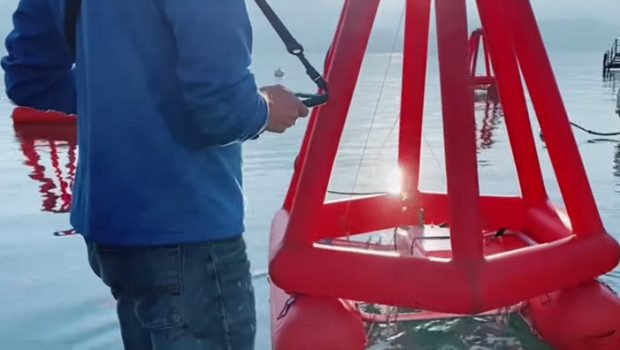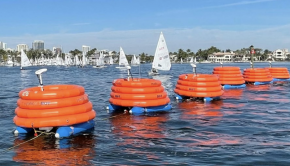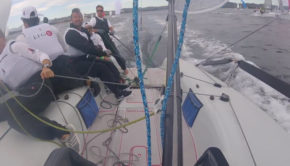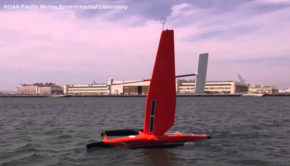Robotic Marks: Evaluating the issues
Published on February 15th, 2021
Competition within sailing creates as much a community of racers as it does race volunteers. To host events, there is equipment to manage, courses to set, fleets to start and finish… it requires people with a passion for being on the water and working together.
Seeking to impact this paradigm and minimize the committee boats and people needed is the robotic mark industry. Using GPS tools and self-powered motors to accurately set the mark while eliminating anchoring… what’s not to like?
While our sport is good at seeking to improve itself, it is equally good at doing so at an ever increasing cost in time and money. A close evaluation of the current expense of running races, and how that would compare with robotic marks, is an important step in this process.
Three-time Olympian Chris Rast, who represents RoboMark, offers some of the additional issues to consider when looking at this evolution:
The robotic mark industry is now going into its 5th year since MarkSetBot introduced its first version. A quick google search will list the following companies that are now vying for your interest:
• MarkSetBot: The first robotic mark hit the racecourse in 2016, based in USA.
• RoboMark: After successful, extensive trials, their first product, the RoboMark C1, is now being offered, based in Switzerland.
• SMark: Watersportmarks, based in Switzerland, offers sMark, a smaller and handy mark.
• SmartMark: Based on the original concept by Roboboj, based in Germany.
• Roboboj: An early producer but seems like they aren’t really in the business anymore. They were in Switzerland.
As with any other project, you need to do your homework first. Talk to your sailors, volunteers, race committee officials, the budget committee, and Racing Directors to develop an extensive list of Must-haves and Nice-to-haves. Here are some points you want to look at:
Venue:
• What kind of wind and wave conditions will you use the marks? If it’s a windy place, you better ensure that the system has some substantial battery capacity.
• Towing capability. If you need to tow your marks to the racecourse area and it is more than a mile away, you will want a design that is either small enough to bring on board or that allows you to easily tow it at faster speeds.
• Pricing. What kind of business model suits you best? Would you just want to buy a complete set or have a yearly rental agreement?
• Warranty and maintenance agreements. How are claims made, how long does the warranty last, how are the robotic marks serviced? What maintenance do they require?
• Who at your club will oversee them and where/how will they be stored?
• Launching and retrieving the marks. What are the possibilities at your club? How easy is it to handle the robotic mark onshore?
• Regulations. Check with your local authorities and government agencies for what requirements you need to fulfill to use robotic marks in your area legally. This can include drone and/or simple remote-controlled water vehicle regulations. Be aware that you are responsible for using this remotely controlled vehicle and it always needs to be in sight of the user.
• Networking capabilities. Most robotic marks use a mobile network for controlling. This sounds great until suddenly there are no more bars on your phone. If you have sketchy/weak reception, you might want to choose a system that works on a closed WIFI Network, so you aren’t dependent on mobile reception.
Event/ Regatta:
• How many robotic marks do you need? Depending on the courses and how many classes you usually sail, you will need a certain number of marks. Just remember, you can quickly reposition robotic marks so that a starting line can easily become a leeward gate.
• Branding. You might want the possibility of branding your marks with a sponsor or other signage. On some designs, this will mean added wind resistance, so make sure they have enough power and battery capacity to do their job for several hours in 20 knots.
Products:
• What functionalities does the robotic mark application need to have? Pre-set courses, battery status, and time indication until all robotic marks are in their respective positions are useful functions.
• Transport concept. If you are traveling a lot with the whole system, you will want to ensure that everything packs up nicely.
• Batteries. Make sure the provided batteries can power the robotic mark without any problems. Most designs don’t allow for easy swapping on the water. How long do they take to fully charge?
• Plan B. What are the options if the remote-control fails? Can you position the robotic mark by pressing a button on itself? Or can you at least attach some tackle and a weight?
• What other special functions can the robotic mark offer? Wind sensors, joystick function, horn signals, etc.









 We’ll keep your information safe.
We’ll keep your information safe.